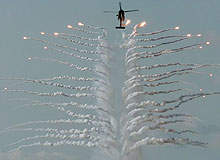
The Trojan Horse was arguably the first decoy used in war, successfully luring the enemy out of their fortress and lulling him into a false sense of security. Today’s decoys and countermeasure tend to focus on air forces and navies, rather than armies, and they are in a constant state of flux as the military seeks to gain a potentially critical advantage.
Afghan war drives sales
In the air, countermeasures and decoys largely take the form of decoy flares and radar countermeasure chaff, designed to protect aircraft from heat-seeking and radar-guided missiles. Esterline Defense Technologies is the producer of the largest and most varied line of combustible ordnance and countermeasure products in the world. The business, based in the US, produces a broad range of flares to suit a variety of applications for the US Army, US Navy, US Air Force and allied governments. The company’s flares can be tailored to meet the needs of unique operational environments and it is the only qualified producer of radar countermeasure chaff in the US. Sales at Esterline are booming with new orders in the first nine months of fiscal 2010 totalling $1.2bn, up more than 18% on the previous year, reflecting strong demand – partly generated by the war in Afghanistan.
It is a similar story at Chemring in the UK, which in November 2010 unveiled a 42% increase in revenue for the fourth quarter. Chemring Countermeasures, along with its sister companies Kilgore and Alloy Surfaces, are “world leaders in the design, development and manufacture of advanced air and naval countermeasures”. Demand from Nato forces for Chemring’s conventional magnesium decoys, of which annual production hit a new record of 380,000 flares in 2009, is helping to drive sales.
Demand for countermeasures and decoys for use in Afghanistan increased markedly in 2010 because the coalition ramped up the air war in the country. Coalition aircraft dropped 1,000 bombs and missiles in October 2010 – one of the highest monthly totals of the nine-year war. As 2010 draws to a close, coalition aircraft have used 4,615 bombs and Hellfire missiles, exceeding the 4,184 dropped in all of 2009. Taliban insurgents use heat-seeking missiles against Coalition aircraft, hence the need for flares and decoys. A number of Nato helicopters have been shot down in Afghanistan since the alliance sent troops into the country in 2001.
Northrop Grumman‘s Guardian directional infrared countermeasure system (DIRCM) is the only aircraft protection system currently in full production. It is now installed or scheduled for installation on several hundred military aircraft to protect fixed-wing transports and helicopters from infrared missile attacks.
The system automatically detects a missile launch, determining if it is a threat and activating a high-intensity laser-based countermeasure system to track and defeat the missile.
IED countermeasures
In December 2010, Northrop Grumman also announced that its airborne surveillance, target acquisition and minefield detection system (ASTAMIDS) had demonstrated that it could detect simulated improvised explosive devices (IEDs) in a US Army evaluation of the system.
“The fundamental goal for ASTAMIDS and all our airborne mine countermeasures systems is to get the soldier, marine, sailor or airman out of harm’s way,” said Dan Chang, Northrop Grumman vice-president of maritime and tactical systems. “These tests proved we’ve achieved our goal with ASTAMIDS. We can identify ground threats and deliver targeting-quality data to adjacent war fighters to destroy the threats and do that in near real time. ASTAMIDS, we believe, is ready to save lives.”
China ‘s missile threat to US supremacy
Meanwhile, the US Navy is focusing on developing countermeasures and decoys to protect its ships from China’s growing naval threat, in particular the anti-ship ballistic missile (ASBM), with an estimated range of 1,500km. The missiles rain down on ships at up to 20 times the speed of sound and are exploiting new radar technology to guarantee accuracy.
Countermeasures could range from updating existing defensive systems and procedures, including those of concealment and deception – including low-observability, or “stealth”, technology to hide ships, to using missile systems to bring down the ASBMs. Sea-based anti-ballistic missile the SM-3 could be modified to intercept China’s ASBM, while long-range, land-based missiles, such as the ground-based interceptors (GBIs), currently deployed in Alaska and California, could be another option. India is also concerned about China’s ASBM programme. Indian Navy Chief Admiral Nirmal Verma said in December 2010 that New Delhi must put in place a mechanism to counter it and protect its warships, particularly the two carrier battle groups.








